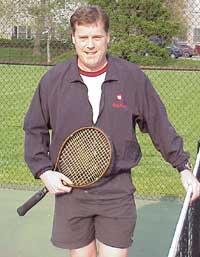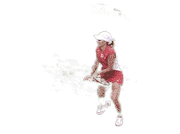Evolution of the Two-Handed Backhand: Part 2
Brian Gordon, PhD
Stroke Mechanics - Development Kryptonite
With the fundamental BH2 approaches outlined in part one of the August issue (Click Here), we now have a framework to assess the pro strokes. Given the goals of this article, the Type 1 BH2 is not relevant. I will start with Alcaraz, then classify Agassi to assess the similarities. Much has been made recently about changes to the Alcaraz BH2. The encouraging thing to me is he is willing to make changes.
I’m always puzzled by how resistant developing players are to even the slightest swing changes. In my day job I have a robust schedule of consulting and coaching accomplished competitive junior and college players. They freak out at even a suggestion of making a simple technical change. It seems they have been thoroughly indoctrinated into the “paralysis by analysis” ideology.
In contrast, the pro level players (futures, challenger, tour) I consult enthusiastically value improving their mechanics. Similar to athletes in most other sports, a significant number of top tennis players in the world (with everything to lose) are constantly implementing adjustments – including draconian changes. I could (but won’t) cite countless examples but Alcaraz is certainly one.
Carlos Alcaraz
In 2024 Alcaraz used a classic T3B swing. A pretty full hook loop with an outside racquet orientation. This implementation was characterized by a smooth transition to the forward swing and extensive dynamic slot (flip). The slot extent was tactically based on shot output. The slot mechanics were optimized in the forward swing with a flip-straight top arm.
Some noticed that by the 2025 Paribas (Indian Wells) this stroke had completely changed. Alcaraz changed the stroke to the most extreme version of the T2O. This includes a straight back swing – extreme meaning that at the end of the backswing both arms were straight when normally a slight bend is maintained in the top arm. Typical of this BH2 classification the racquet was oriented to the outside but the flip-straight became obsolete.
It would be very interesting to know why he made this change, or why any top player makes changes to something that works. Presumably they are always looking for even the smallest advantage or area for improvement. Reluctant developing players should note this is probably one reason they ARE at the top. One could surmise he intended to make the stroke shorter and quicker to deal with fast surfaces or in general.
The arm-chair analysts went crazy on the internet opining about the pros and cons of this change (I’ve heard since I don’t pay attention). Then came the clay court season and the stroke changed again. At Roland Garros 2025, we could see he was back to the T3B version but with a smaller hook loop (hybrid) which is very similar to what Djokovic has evolved into. Again why? Of course his T2O implementation was very rigid (double straight arm set up) – perhaps too restrictive in generating hand speed and dynamic slot quality.
Andre Agassi
Many would argue that Andre Agassi had the greatest BH2 in history. But did he stumble upon (innovate) the template for the “perfect” BH2 decades ago? In many core technical respects the current Alcaraz implementation is eerily similar to the current Djokovic implementation, which is very similar to the Agassi BH2.
The basic geometry of these strokes is essentially the same. All three are T3B with hybrid hook loops ending in an outside racquet configuration and culminating with a straight top arm. The Agassi version is a bit unique in that he also keeps his bottom arm straight through contact.
The straight bottom arm seems to be an element of early BH2 implementations. The Agassi predecessors exhibited this trait more or less. Certainly Connors had a very straight bottom arm. Borg also used a straight bottom arm on most shots although he displayed more variability. Did Agassi copy these, or perhaps this was a coaching element at the time?
Geometry aside, the primary difference between Alcaraz and Agassi BH2 versions is in the biomechanics (kinetics). While there is evidence of a minimal dynamic slot mechanism (perhaps the first) in the Agassi BH2, it is not as prominent nor sophisticated as in the Alcaraz BH2. Was this simply because his backhand was relatively flat (on average 1,800 RPMs) or that dynamic slot mechanics were not understood by his (or any) coaches?
The Geometry/Biomechanics Link
Increased use of dynamic slot mechanics in modern BH2 strokes is correlated with a change in the bottom arm elbow angle. While early BH2 strokes tended toward a straight bottom arm in the forward swing, the modern BH2 is overwhelmingly hit with a bent bottom arm in the second half of the forward swing.
The kinetic goal of the dynamic slot is to enhance the ability to produce VERTICAL racquet speed used to generate spin (and trajectory). This enhancement is in the form of neuromuscular facilitation to top arm shoulder internal rotators (ISR). The problem on the BH2, as opposed to the forehand, is that the other hand is attached to the racquet.
The closed loop created by having both hands gripping the racquet makes it more difficult to produce the vertical component of racquet head speed in general. However, some geometric configurations make it easier than others. In particular, a bent bottom arm in conjunction with a straight top arm allows ISR to more purely target the vertical component of racquet speed.
“The More Things Change…”
In many respects the core patterns seen in the original Type 2 and Type 3 BH2 strokes are the same as we see in the current versions. Modern players use straight backswings AND hook-loop backswings just like their historical counterparts. It would be hard to conclude there has been a clear identifiable evolution in the execution of the stroke.
What is clear is that the basic patterns have been optimized from a biomechanical perspective. But, clearly not all modern players utilize all optimizations. The optimizations were likely introduced through trial and error by athletes over time. Great players are the ultimate innovators by necessity and definition - other players and coaches simply follow the leaders.
If there has been an evolution, it has been in understanding by those so inclined to study the progressions. My coaching experience and research indicate the hybrid hook-loop backswing, outside racquet orientation to start the forward swing, tactically variable dynamic slot utilizing flip-straight extension of the top arm, and bent bottom arm approaching contact are the optimal ingredients to build the BH2 for any level of play.




